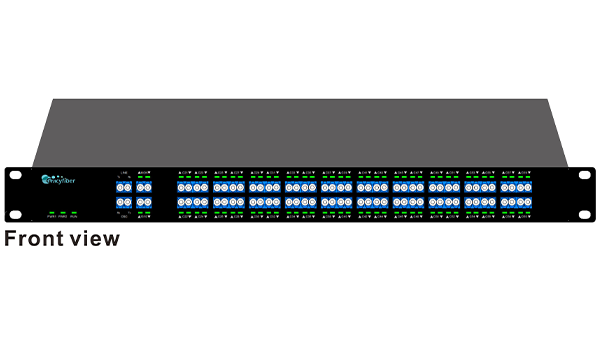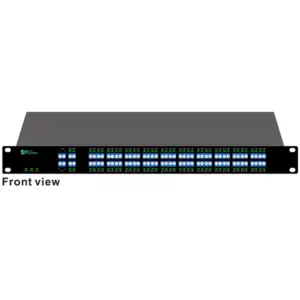Learn about the breakthrough products of GracyFiber intelligent AWG systems. Explore advances in optical networking technology.
Today, Gracyfiber announced the launch of its latest product – the intelligent AWG system. The system uses innovative technology to significantly improve the resource utilization and transmission efficiency of optical fiber networks, bringing revolutionary changes to the field of optical fiber communications.

In this article, we will introduce the definition, functions and application areas of intelligent AWG systems to help you understand its importance in modern scientific research and engineering fields. As a high-precision, high-speed signal generator, the intelligent AWG system has flexible waveform editing, modulation functions and automatic control capabilities. Let’s explore the wonderful world of intelligent AWG systems together!
What is an intelligent AWG system
The intelligent AWG system is an optical fiber communication system based on array waveguide grating (AWG). It can dynamically adjust the wavelength of optical signals according to the needs of network traffic, thereby improving the resource utilization and transmission efficiency of optical fiber networks.

The working principle of the intelligent AWG system is to use the optical characteristics of the AWG to multiplex or demultiplex optical signals according to wavelength. An AWG consists of an array of optical fibers, each with a specific wavelength response. When the optical signal enters the AWG, it will be coupled out by different optical fibers, thereby achieving wavelength multiplexing or demultiplexing of the optical signal.
The intelligent AWG system has the following advantages:
-
Easy to deploy and manage: The intelligent AWG system adopts a modular design and is easy to deploy and manage.
-
Small size and low power consumption: The intelligent AWG system uses advanced optical devices, has small size and low power consumption, and is suitable for various application scenarios.
-
Improving the transmission efficiency of optical fiber networks: The intelligent AWG system can reduce the transmission loss of optical signals, thereby improving the transmission efficiency of optical fiber networks.
-
Reduce the operating cost of the optical fiber network: The intelligent AWG system can reduce the equipment and maintenance costs of the optical fiber network, thereby reducing the operating cost of the optical fiber network.
-
Improving the resource utilization of optical fiber networks: The intelligent AWG system can dynamically adjust the wavelength of optical signals according to the needs of network traffic, thereby avoiding the waste of optical fiber resources.
Comparison between intelligent AWG system and traditional AWG system
The traditional AWG system is an optical fiber communication system based on arrayed waveguide grating (AWG), which multiplexes or demultiplexes optical signals according to wavelength. An AWG consists of an array of optical fibers, each with a specific wavelength response. When the optical signal enters the AWG, it will be coupled out by different optical fibers, thereby achieving wavelength multiplexing or demultiplexing of the optical signal.
The intelligent AWG system is based on the traditional AWG system and adds reconfigurability functions. The intelligent AWG system can dynamically adjust the wavelength of the optical signal according to the needs of network traffic, thereby improving the resource utilization and transmission efficiency of the optical fiber network.
Advantages and differences between the two:
| characteristic | Intelligent AWG system | Traditional AWG system |
|---|---|---|
| Reconfigurability | Optical signal wavelength can be dynamically adjusted according to network traffic requirements | Non-reconfigurable, wavelength configuration is fixed |
| flexibility | Support multiple optical fiber transmission modes | Limited supported transfer modes |
| Scalability | Fiber optic network capacity can be expanded as needed | Limited scalability |
| cost | higher | lower |
Why smart AWG systems are replacing traditional AWG systems
-
Continuous growth of network traffic: With the popularity of the Internet and the richness of applications, network traffic is growing. The wavelength configuration of the traditional AWG system is fixed and cannot meet the dynamic changes of network traffic. The intelligent AWG system can dynamically adjust the wavelength of the optical signal according to the needs of network traffic, thereby improving the resource utilization and transmission efficiency of the optical fiber network.
-
Continuous expansion of optical fiber networks: Optical fiber networks are expanding into areas such as metropolitan area networks and access networks. The traditional AWG system has limited scalability and cannot meet the continuous expansion of optical fiber networks. The intelligent AWG system is scalable and can meet the continuous expansion of optical fiber networks.
-
Technological progress: The continuous advancement of optical communication technology has caused the cost of intelligent AWG systems to continue to decrease. The cost gap between smart AWG systems and traditional AWG systems is narrowing.
Application scenarios of intelligent AWG system
The intelligent AWG system has the advantages of reconfigurability, flexibility, scalability and other advantages, and can be widely used in optical fiber communications, data centers, cloud computing and other fields.

Optical fiber communication
In the field of optical fiber communications, intelligent AWG systems can be used in the following application scenarios:
-
Backbone Network: The intelligent AWG system can be used for optical transmission and switching in the backbone network to improve the resource utilization and transmission efficiency of the backbone network.
-
Metropolitan area network: The intelligent AWG system can be used for optical transmission and switching of metropolitan area networks to meet the huge demand for bandwidth in metropolitan area networks.
-
Access network: The intelligent AWG system can be used for fiber-to-the-home (FTTH) services in the access network, providing users with high-bandwidth and high-reliability broadband access services.
Specific application cases:
-
In backbone networks, intelligent AWG systems can be used to connect different cities or countries to achieve high-speed, large-capacity data transmission. For example, China Mobile deployed an intelligent AWG system in its backbone network, increasing the transmission capacity of the backbone network by 10 times.
-
In metropolitan area networks, intelligent AWG systems can be used to connect different operators or enterprises to provide high-bandwidth business services. For example, China Telecom has deployed an intelligent AWG system in its metropolitan area network to provide users with gigabit broadband access services.
-
In the access network, intelligent AWG systems can be used to extend optical fiber to users’ homes to provide fiber-to-the-home (FTTH) services. For example, China Unicom has deployed an intelligent AWG system in the access network to provide users with 1000M broadband access services.
Data center
In the data center field, intelligent AWG systems can be used in the following application scenarios:
-
Server interconnection: The intelligent AWG system can be used to connect different server racks to achieve rapid interconnection between servers.
-
Storage interconnection: The intelligent AWG system can be used to connect different storage devices to achieve high-speed interconnection of storage networks.
-
Cloud Computing: Intelligent AWG systems can be used to connect different cloud data centers to achieve rapid sharing of cloud resources.
Specific application cases:
-
In terms of server interconnection, the intelligent AWG system can be used to connect different server racks to achieve rapid interconnection between servers. For example, Google deployed an intelligent AWG system in its data center to increase the interconnection speed between servers by 10 times.
-
In terms of storage interconnection, intelligent AWG systems can be used to connect different storage devices to achieve high-speed interconnection of storage networks. For example, Amazon deployed an intelligent AWG system in its data center to increase the transmission speed of the storage network by 5 times.
-
In terms of cloud computing, intelligent AWG systems can be used to connect different cloud data centers to achieve rapid sharing of cloud resources. For example, Microsoft deployed an intelligent AWG system in its cloud computing platform, which doubled the speed of sharing cloud resources.
Other application scenarios
In addition to the fields of optical fiber communications and data centers, intelligent AWG systems can also be used in the following fields:
-
National Defense and Security: Intelligent AWG systems can be used in communication systems in the fields of national defense and security to improve the security of communication systems.
-
Industrial Control: Intelligent AWG systems can be used in communication systems in the field of industrial control to improve the reliability of industrial control systems.
-
Healthcare: Intelligent AWG systems can be used in medical imaging systems in the healthcare field to improve the clarity of medical imaging systems.
Summary
The intelligent AWG system is one of the important technologies in the field of modern optical communications. It has the advantages of reconfigurability, flexibility, scalability and other advantages, and can be widely used in optical fiber communications, data centers, cloud computing and other fields. With the continuous development of optical communication technology, the application of intelligent AWG systems will become more widespread.
We provide high-quality smart AWG systems to meet your test and measurement needs. By choosing our products, you gain the benefits of high-quality signal generation, flexible waveform editing and automated control.
Whether you are conducting scientific research, conducting engineering testing, or performing product verification, intelligent AWG systems are your ideal choice! If you have any needs or questions about smart AWG systems, our team is here to provide you with professional support.
Lntelligent AWG System FAQ
An Intelligent AWG system is an advanced testing instrument used to generate and transmit complex telecommunication signal waveforms. It features high bandwidth, sampling rates, and multiple channel outputs, along with integrated signal modulation and analysis capabilities.
An Intelligent AWG system enhances the capabilities of a traditional AWG by offering advanced features such as higher bandwidth, increased sampling rates, multi-channel outputs, built-in signal modulation, and analysis functions, as well as automation and remote control capabilities.
Intelligent AWG systems find applications in various fields, including communication system testing and evaluation, high-speed digital signal processing, radar system simulation, wireless spectrum testing, and educational research.
Intelligent AWG systems are used to generate complex modulation signals for testing and evaluating components like modems, demodulators, receivers, and transmission links in communication systems. They simulate real-world communication scenarios to assess system performance and robustness.
Intelligent AWG systems generate high-speed and complex digital signal waveforms for testing and validating digital signal processing algorithms, digital filters, clock recovery circuits, and other related components. They are essential for developing and optimizing high-speed communication systems and digital signal processing devices.
Intelligent AWG systems can generate radar echo signals with varying parameters and characteristics, allowing simulation of different radar targets and environmental conditions. This enables the evaluation of radar system performance, target detection, tracking algorithms, and system optimization.
Intelligent AWG systems generate various modulation signals, interference signals, and noise signals for testing and evaluating aspects like spectrum analysis, signal detection, interference suppression, and demodulation performance of wireless devices.
Yes, Intelligent AWG systems serve as valuable educational tools and research platforms. They aid in teaching and learning communication principles, signal processing algorithms, and can support researchers in generating novel signal waveforms for experimentation, advancing communication and electronic fields.
Intelligent AWG systems often feature remote control and automation capabilities, allowing users to operate the system remotely through programming interfaces like SCPI commands or software interfaces. This facilitates remote testing, automated measurements, and integration into larger test setups.
Intelligent AWG systems may include integrated signal analysis capabilities such as spectrum analysis, eye diagram displays, and time-domain analysis. These features enable real-time analysis and evaluation of the generated signals, supporting comprehensive signal characterization and system performance assessment.









